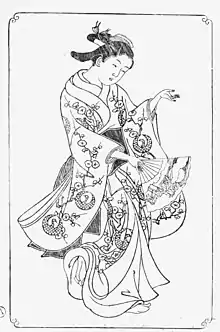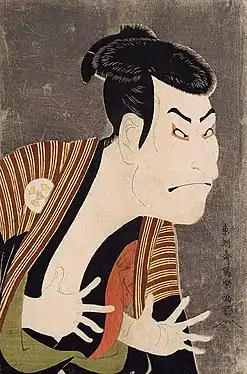Sumizuri-e
Sumizuri-e is a type of monochromatic woodblock printing that uses only black ink. It is one of the earliest forms of Japanese woodblock printing, dating back to the Nara period (710 – 794).

Sumi-e translates to “ink wash painting,” which is a type of East Asian brush painting technique that uses black ink. The oldest example of sumizuri-e printing was discovered in the One Million Pagodas. These Pagodas were religious works commissioned by the Empress Shōtoku to be distributed to Japan's ten major temples.[1] The miniature wooden pagodas were made to honor the Buddhist deities and thank them for holding back the Emi Rebellion of 764. Inside of these relics, each pagoda contains a darani, or Buddhist invocation, that was printed on small scrolls.[2] Historians believe this is the oldest example of sumizuri-e printmaking, but due to their religious importance, it is antagonistic to remove and study all of the sutra scrolls. X-ray photos are used to observe these pagodas from a distance and allow researchers to recreate the sutras.[3] The technology is employed to detect the age and wear of the scrolls.
_and_Invocation_MET_30_47ac_INSIDE.jpeg.webp)
As the printmaking movement developed, artists began painting the sumizuri-e prints by hand to color in the images (kappazuri-e).
References
- "One of the "One Million Pagodas" (Hyakumanto) and Invocation". www.metmuseum.org. Retrieved 2019-11-04.
- "Kyoto National Museum".
- Albertin, F.; Astolfo, A.; Stampanoni, M.; Peccenini, Eva; Hwu, Y.; Kaplan, F.; Margaritondo, G. (2015-01-30). "Ancient administrative handwritten documents: X-ray analysis and imaging". Journal of Synchrotron Radiation. 22 (Pt 2): 446–451. doi:10.1107/S1600577515000314. ISSN 0909-0495. PMC 4786057. PMID 25723946.
